Stored

The series produces an eerie prediction for what's to come. "A day in summer 2020. Social isolation has become normal. The new disease is called hypochondria," says Roché.
Check out the rest of the series below.
Stay informed on our latest news!

The series produces an eerie prediction for what's to come. "A day in summer 2020. Social isolation has become normal. The new disease is called hypochondria," says Roché.
Check out the rest of the series below.











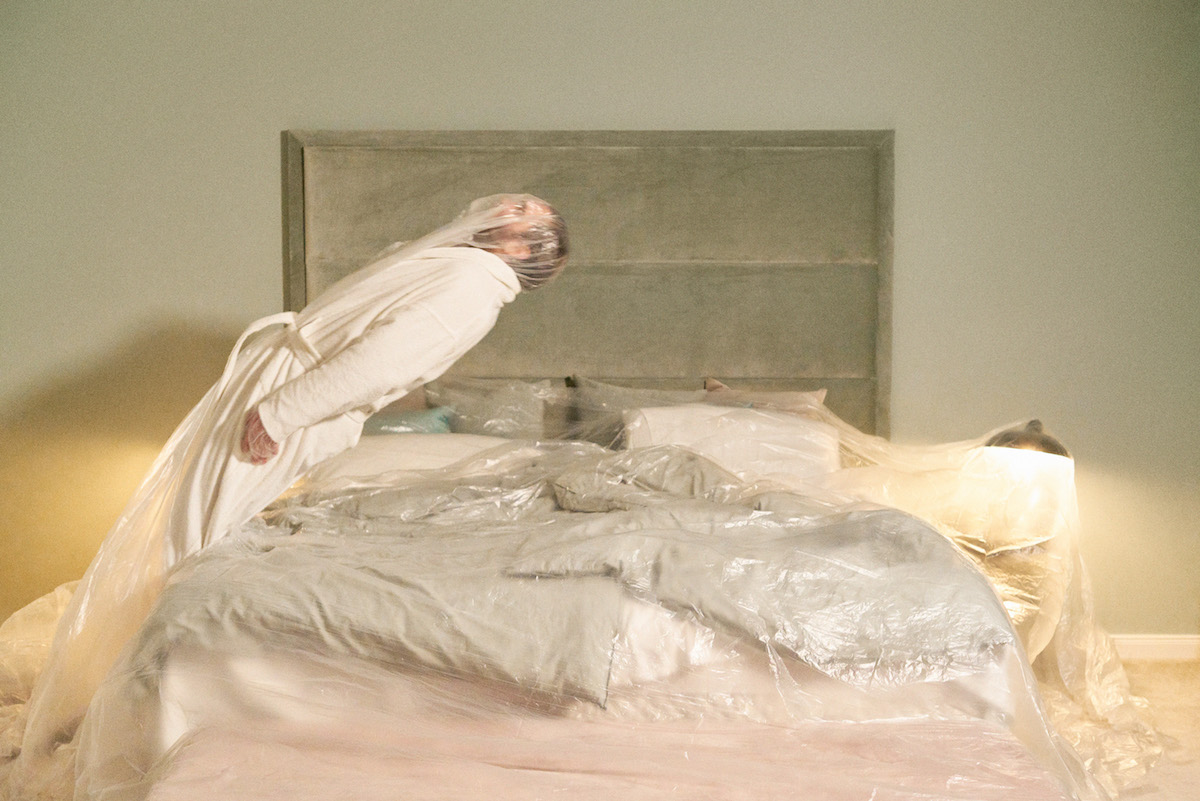


The sheer number of presentations made it impossible to see it all, and just like a choose-your-own-adventure book, no two tales of design week are alike. Taking part in each design week is a commitment, and it’s together we ke going, until the last show, the last party, the last drink. So we followed our friends and let the stream of openings and parties guide us from one installation to the next, fueled by childlike curiosity and the deep desire to be transported into otherness, even if just for a few moments. The commercial value is, of course, underlying, but during those days, it somehow feels beside the point. Design week might technically span over a week, sometimes two (or three, who’s counting?), but the obsession for that one piece, the way that material caught the light, the feeling of being in that one room, or the memory of that one late-night conversation outside so-and-so’s exhibition lingers on. What follows is just a glimpse of what we saw, loved, and are still reeling from.
Milan
Photos by Sean Davidson
Tbilisi and Paris-based Rooms Studio introduced a series of six sculptural, mix-media beds – their firsts – with their 5Vie installation, Bedrooms, emphasizing the role of these deeply personal spaces and how they carry the most intimate elements of our inner worlds.

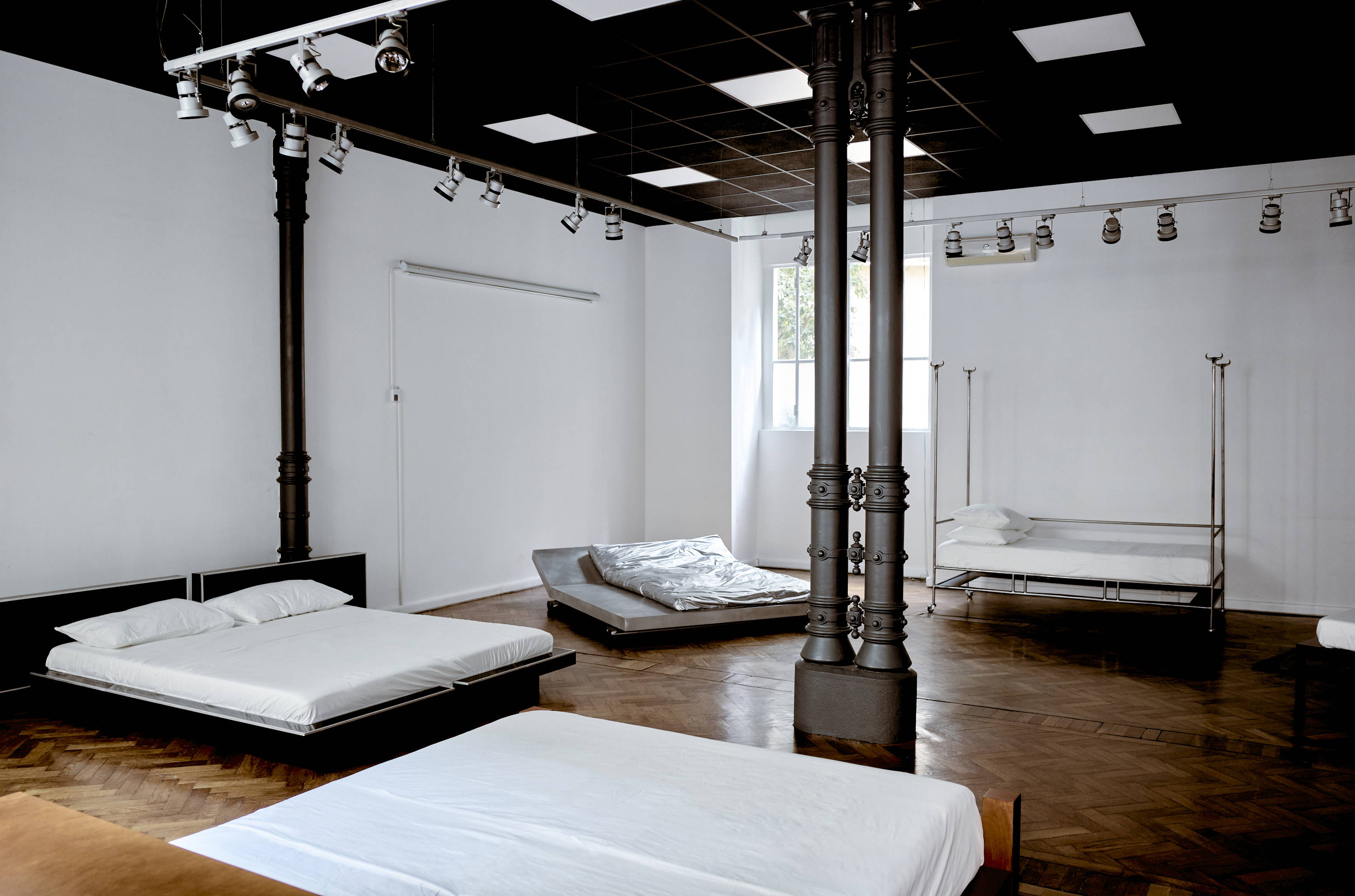
Bedrooms, Rooms Studio
Australian studios Volker Haug and Flack presented Me and You, a lighting collection born from an unexpected mishap: during a Flack installation, a vintage light broke and urgently needed to be replaced. The aesthetic language for Me and You naturally unfolded, showcasing Flack’s artful signature blend of interior and industrial design.
Zürich-based, British designer Grace Prince presented Attentive Still, a series of four new glass and hammered works that explore balance and structure, developed during her Numeroventi artist residency in Florence.

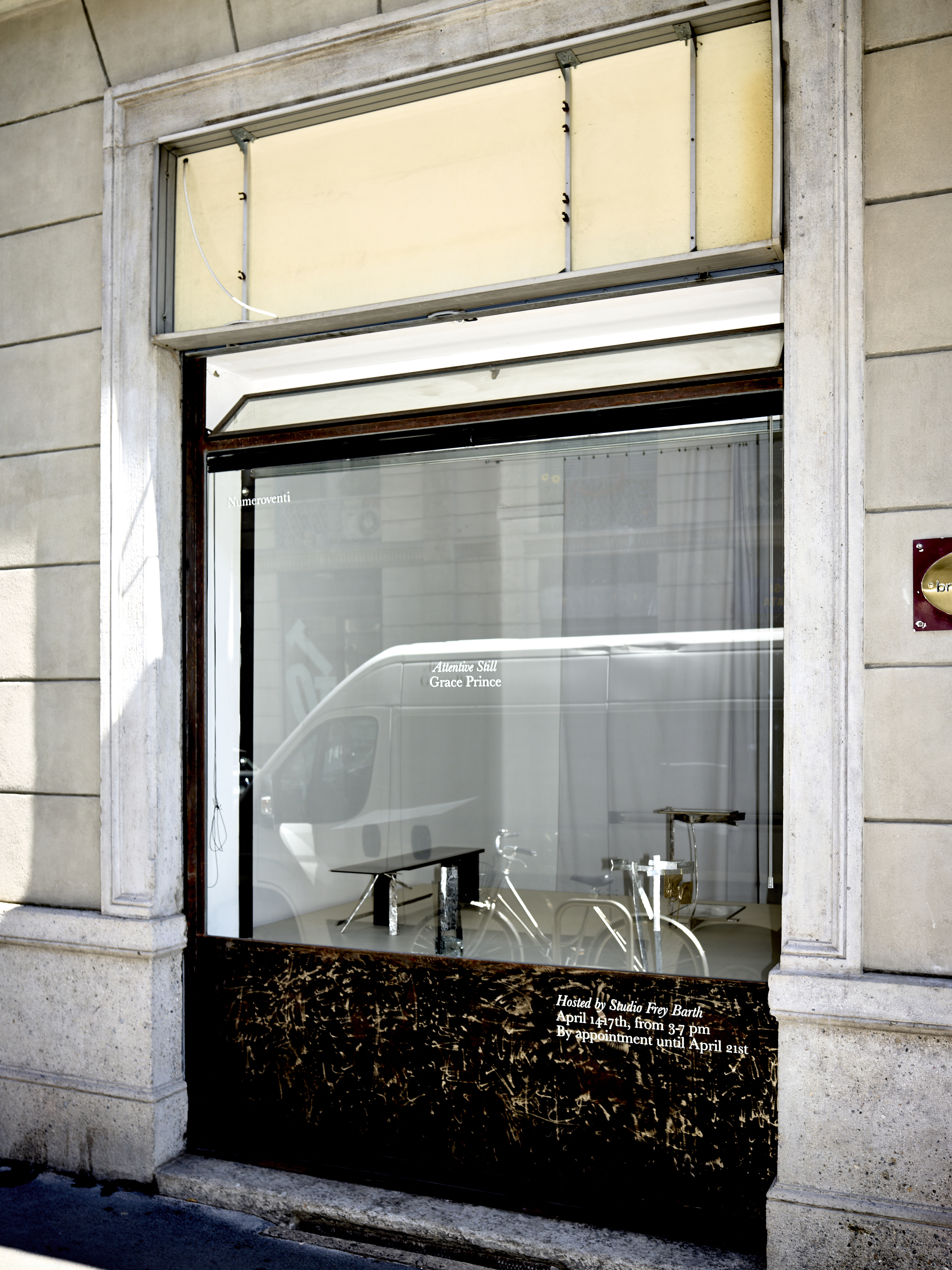
Me and You, Volker Haug and Flack
Attentive Still, Grace Prince
For their first Salone, NYC gallery VERSO’s showcase highlighted the fusion of traditional craftsmanship and cutting-edge design from Palma and Bravo studios, reflecting the cultural identities and material use of Brazil and Chile.


VERSO Gallery Showcase
Montréal lighting studio Lambert & Fils teamed up with Milanese designers from DWA Design Studio to present the third iteration of Caffè Populaire, introducing their latest collection, ISLE, designed by Zoë Mowat, in conversation with UNICO, a series of vessels designed by DWA using recycled plastics from Pedrali. The garden bar concept invited guests to enjoy drinks served in Sophie Lou Jacobsen glassware and snacks by LA-based food art studio, Ananas Ananas.
Barcelona gallery VASTO presented sisters Anna and Maria Ritsch's Cup Holder, a photograph from their ‘Dissolving Series’ which transforms 3D printed objects into abstract photographic compositions, alongside a curated collection of functional collectibles and avant-garde stonework by emerging designers, at the newly enhanced Marimar Club.


Caffè Populaire, Lambert & Fils and DWA Design Studio
Cup Holder, VASTO Gallery
5VIE presented Omi Iyọ, a powerful installation by Nigerian designer Nifemi Marcus-Bello, curated by Design Miami Editor-in-Chief, Anna Carnick. The polished stainless steel piece, resembling a boat's hull, symbolizes the perilous journeys of undocumented migrants from Africa to Europe. Reflecting on human impact, the installation, filled with salt flowing to form patterns below, honors the memory of those lost and emphasizes our interconnectedness amidst Italy's significant geopolitical role in migration debates.
Itinerant organization CONTRIBUTIONS Design presented Passaggi, a collaborative installation bringing together the voices of designer Sophie Lou Jacobsen, art director Giulia Nardi of COSE Journal and photographer Adrianna Glaviano. Presented at Spazio Martin, Passaggi explored the emotive powers of domestic objects.


Omi Iyọ, Nifemi Marcus-Bello and 5VIE
Passaggi, CONTRIBUTIONS Design
Milanese giants cc-tapis and Tacchini unveiled the Rude Arts Club, introducing British trailblazer Faye Toogood and Tacchini’s first collaborative furniture collection and the third installment of Toogood's handmade rugs with cc-tapis. The exhibition transformed unique rooms with tactile lights, plush fabric-clad walls, and sculptural furniture, blending wit and style.
FormaFantasma’s La Casa Dentro at Fondazione ICA presented a selection of new works exploring the home as both a physical space and a nexus of personal identity and collective memory. A Salone favorite, the exhibition blended rationalist design elements with sentimental and decorative features inspired by childhood memories.
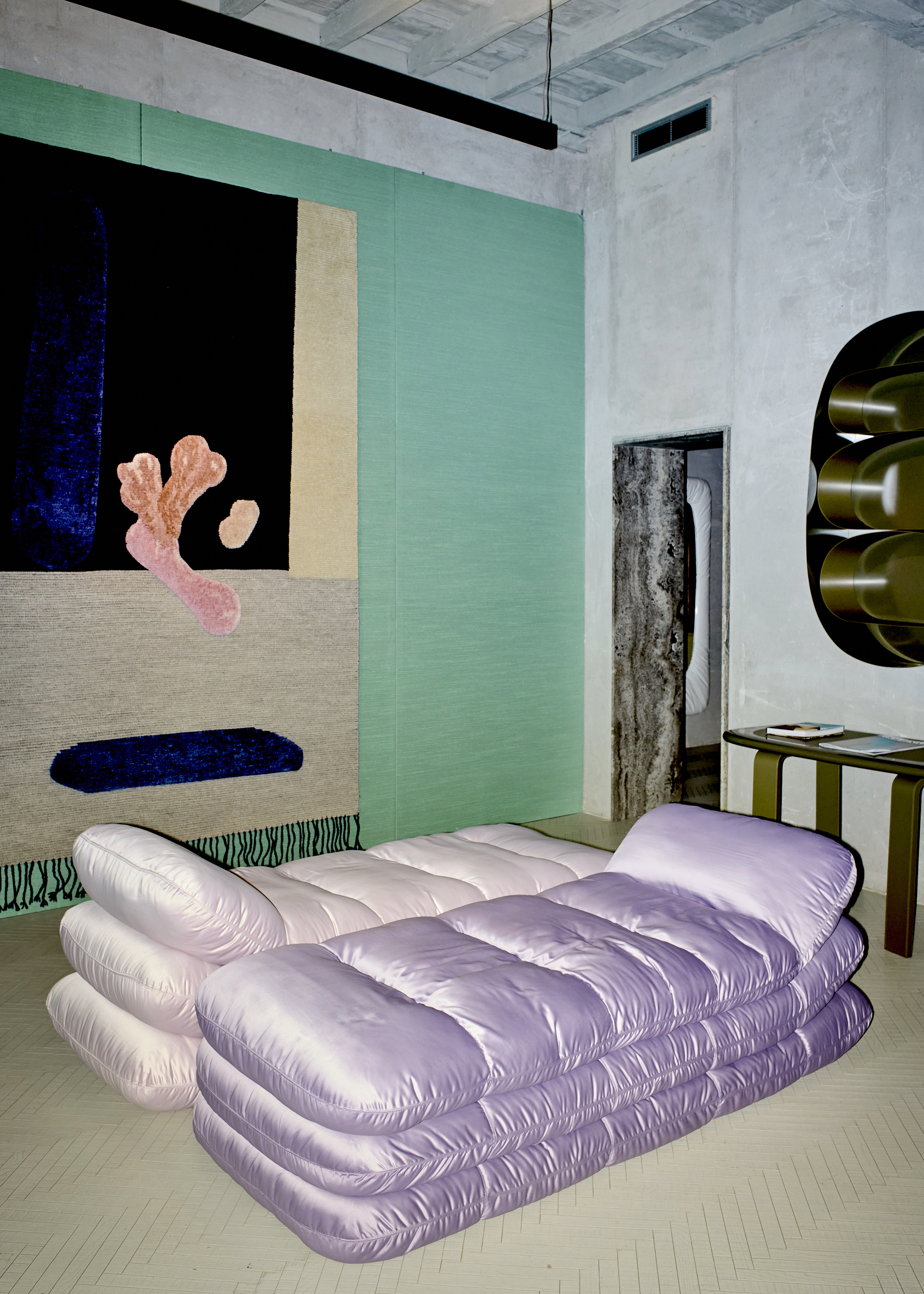

Rude Arts Club, cc-tapis and Tacchini
La Casa Dentro, FormaFantasma
New York
Nick Ozemba and Felicia Hung — the dynamic duo behind Brooklyn-based design studio In Common With — celebrated the much anticipated opening of Quarters, an expansive 8,000-square-foot space designed like a well-appointed home where everything — furniture, lighting, art, and even pantry provisions — is shoppable. The opening night was the talk of the town, with the space being christened with late-night dancing and drag performances, rightly so.
Sight Unseen’s co-founder Monica Khemsurov launched Petra, an online collection of artistic hardware by leading designers at Blue Green Works’ Chinatown showroom. Featuring handmade fixtures by over thirty contributors from around the world, Petra includes exclusive pieces from metal pulls by Chris Wolston to BD Barcelona’s licensed reproductions of Salvador Dalí’s elaborate 1937 ‘Rinoceróntico’ door handle. The design week showcase also included ten cabinets and consoles by ten designers commissioned for the occasion by Khemsurov and Sight Unseen's second half, Jill Singer, including Steven Bukowski, Rest Energy and Studio POA.


Quarters, In Common With. Photography by Hunter Abrams.
Petra, Sight Unseen and Blue Green Works. Photography by Pippa Drummond.
Seoul-born, New York-based designer Minjae Kim presented Arbiters Corner under the sculptural canopy of the Gallery at Ace Hotel Brooklyn. This exhibition marked the final chapter of the year-long A!R partnership between Ace Hotel and multidisciplinary studio FORT MAKERS, and featured Kim’s work conceptualized during his month-long stay at the hotel. The central artwork depicted a chess game in progress, exploring themes of accessibility and conflict.
Spanning lighting, decorative objects and furniture, A Year Without a Kiln — Simone Bodmer-Turner’s latest solo exhibition at Emma Scully Gallery — was a marker in a year when the artist moved her life and practice from an apartment and studio in Brooklyn to a farmhouse and orchard in Massachusetts. During this time, Bodmer-Turner didn’t have access to her kiln, the primary tool behind her clay creations, and with this absence, she was presented with the opportunity to introduce different materials into her practice.


Arbiters Corner, Minjae Kim. Photography by Sean Davidson.
A Year Without a Kiln, Simone Bodmer-Turner. Photography by Dani Case.
Chinatown duo Sunfish unveiled their spring collection at founders Julia Eshaghpour and Kevin Hollidge’s own home. For this new series, the couple drew influence from techniques and design movements across time and place, teasing at the Art Deco trend with shino-glaze and handcrafted tile-clad tables, and wood-framed screens with hand painted depictions of birds.
David Michon’s excellent weekly décor substack FOR SCALE celebrated its first URL to IRL moment with the publication of an inaugural print newspaper at Colbo. The event coincided with Glamor Butch, an eclectic collection of objects from NYC artists and makers, selected by Michon’s discerning eye.


Spring Collection, Sunfish. Photography by Lucia Bell-Epstein.
FOR SCALE, David Michon. Photography by Jason Lê.
SuperHouse's The Odd Couple (on view through August 17), focuses on American art furniture over the past four decades, showcasing the diverse tendencies, philosophies, and narratives of transgenerational American artists. Highlights include historical pieces from the functional art and studio craft movements, as well as contemporary works demonstrating the lasting legacies of conceptual rigor and expert craftsmanship from artists like Pippa Garner, Dan Friedman, Michele Oka Doner, and Kim Mupangilai.
The annual group showcase Jonald Dudd made its return to NYCxDesign, this time curated by Charles Constantine, co-founder and creative director of Bestcase. Held at the former sex shop Contact Sports, the exhibition, titled Forbidden Fruit, offered a freeform exploration of furniture making, highlighting the work of 30 designers and studios.


The Odd Couple, SuperHouse. Photography by Luis Corzo.
Forbidden Fruit, Jonald Dudd. Photography by Matthew Gordon.
For their design week debut, artist duo Wretched Flowers presented Artifact V.2, their second collection of lighting and decorative objects inspired by historical objects from museum archives. Highlights included the revival of Tramp Art modernized using laser-cut stainless steel, and a tubular chainmail floor lamp with optional cast-pewter stars traditionally found on Amish quilts.
LA’s beloved Marta Gallery made their NADA debut with Correspondence / Coexistence, putting in conversation artists Myoung-Ae Lee, from South Korea, and Isabel Rower, based out of NYC. The dual showcase emphasized generational lineage and the evolving zeitgeist, with Lee's typology-defying canvases and Rower's ceramic works that playfully mimic cardboard structures.


Artifact V.2, Wretched Flowers. Photography by Wretched Flowers.
Correspondence / Coexistence, Marta Gallery. Photography by Sean Davidson.
Lindsey Adelman has long followed the porous border between art and design. A Realm of Light, presented at TIWA Gallery, displayed a constellation of oil lamps — some hanging and others sitting on surfaces — transforming the space into a warm, meditative landscape adorned with hand-stitched hanging panels by textile artist and La Réunion founder, Sarah Nsikak.
For the second consecutive year, West Village gallery Demisch Danant shone a light on Noé Duchaufour-Lawrance. The Lisbon-based French designer — a rare contemporary amongst the gallery’s roster of historical greats — showcased a selection of works from Made in Situ, a studio project that advocates for a practice rooted in a specific territory, exploring its materials, artisans, craftsmanship and cultural vernacular.


A Realm of Light, Lindsey Adelman. Photography by Brian Ferry.
Made in Situ, Demisch Danant. Photography by Lucas Creighton.
Jacqueline Sullivan Gallery’s A Room is an Archive of Touch, on view through July 20, is an intimate exploration of memory and domesticity, inspired by Lisa Robertson's essay "Atget's Interiors." The exhibition, featuring meticulous textile pieces by Grace Atkinson, pinched clay ceramics by Jennefer Hoffmann, and kiln-formed cast glass (known as pâte de verre) sconces Natalie Weinberger, highlights how the cadence of habit in rooms and objects creates an archive of the past through gestures and intuition, reflecting both the beauty and pain of remembering.
In industry jargon, “time and materials” is a means of telling the story of a finished piece. To honor the design process, Sarah Zames and Colin Stief — of interiors studio General Assembly — asked ten designers to create a piece of furniture or decor with that notion in mind. On view at their Boerum Hill shop, Assembly Line, Time and Materials presented new works by the likes of Bowen Liu, Danny Kaplan, Fern, and Steven Bukowski.


A Room is an Archive of Touch, Jacqueline Sullivan Gallery. Photography by William Jess Laird.
Time and Materials, General Assembly. Photography by Brian Ferry.
Copenhagen
With A Thousand Moons, Danish-Egyptian architect Salem Charabi introduced a body of work developed over the past two years for a single commission, a private residence in California. Before sending them on a transatlantic journey, Charabi enlisted his dear friend and collaborator, art director Owen Dodd, to orchestrate a public viewing and celebration. The thirty-eight pieces of furniture stood proudly atop their respective shipping crates, marking their final moments in the workshop where they were crafted.
Danish textiles brand Tekla in collaboration with Finnish furniture manufacturer Artek debuted a textile collection, celebrating architect, designer and Artek co-founder Aino Aalto, commemorating her 130th birthday. Adorned with Alto’s iconic Kirsikankukka, or cherry blossom, pattern which she created as an homage to Japanese art and design, the collection honors "the beauty of the every day".


With A Thousand Moons, Salem Charabi
Tekla and Artek Textile Collection
Milan-based designer Natalia Criado showcased a selection from her surrealist, jewelry-like tableware collection in RESILIENCE, a group show exploring the enduring flexibility, reliability and strength of wood, metal and concrete, alongside Danish architect designer Danielle Siggerud, artist Susanne Storm at rug studio Knothouse’s showroom.
Serbian-born and Paris-based artist and designer Ana Kraš celebrated the launch of her objects brand, Teget. After years spent responding to project briefs, Kraš is now able to give her vision full freedom, letting go of any commercial constraints. In conjunction with the showcase of Teget’s first collection, Static Noise, Kraš also presented a capsule collection of mesh garments with her longtime collaborators from Danish fashion brand, Saks Potts.
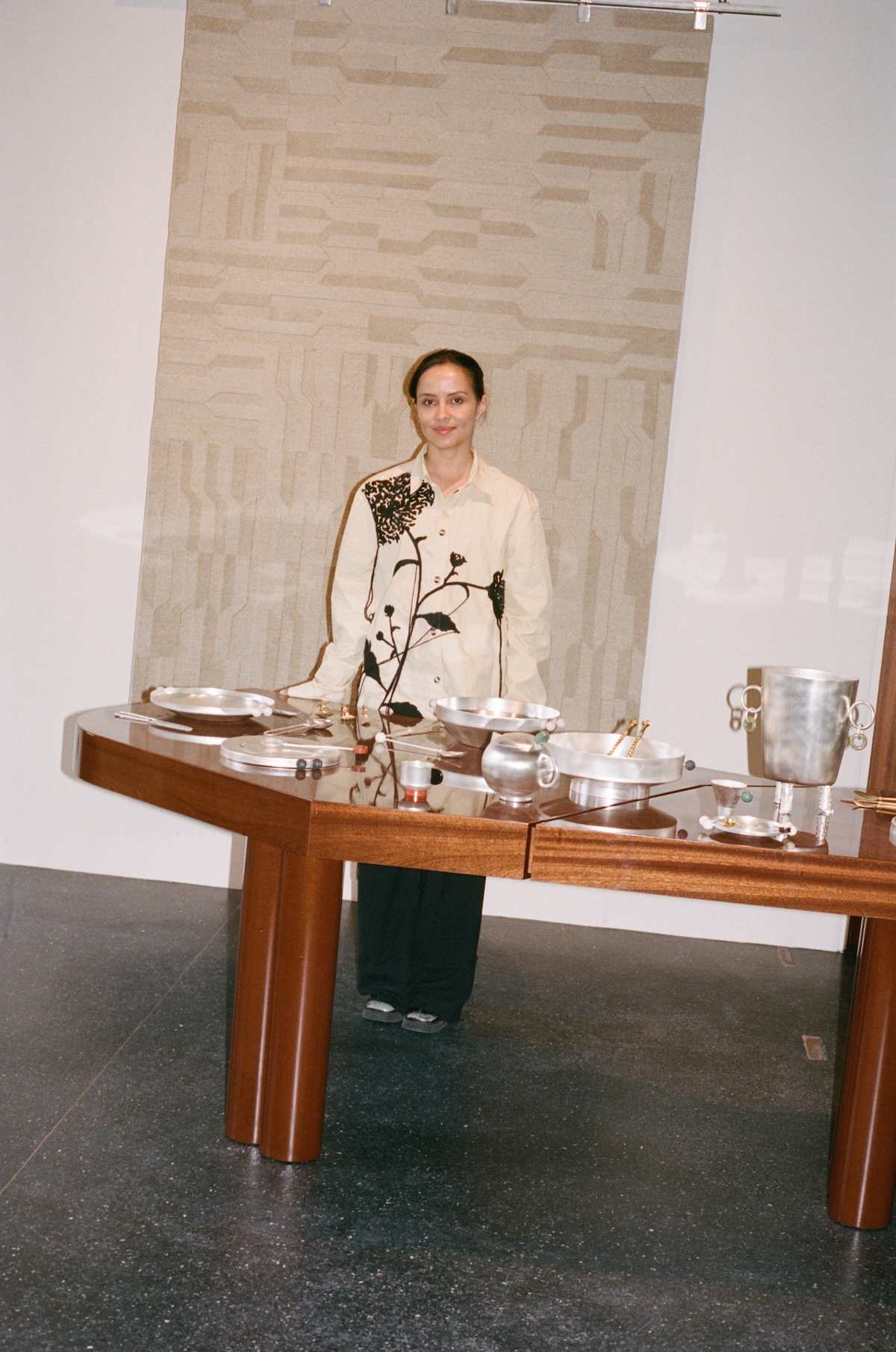

RESILIENCE, Natalia Criado, Danielle Siggerud, and Susanne Storm
Static Noise, Teget by Ana Kraš
Exploring the intersection of art, design and food, FRAMA and Faye Toogood came together for the first time with COLLAGE, an amplified view of one of our most human experiences: sharing a meal. Toogood’s spatial intervention in FRAMA’s Copenhagen HQ brought color and extreme proportions into the historic 1878 building, inviting visitors to dine throughout the space amidst playful tactile sculptures.
With Shaping the Future, Carl Hansen & Søn — the third-generation family-run company and warrants of Scandinavian design — presented new lighting and furniture launches by Børge Mogensen, Kaare Klint, Rikke Frost, Vilhelm Lauritzen and Henning Koppel while celebrating the 110th anniversary of Hans J. Wegner. The showstopper was the reedition of Kaare Klint’s Spherical Bed, a masterpiece originally introduced in 1938 at the Cabinetmakers' Autumn exhibition, under the title A Lady’s Boudoir.

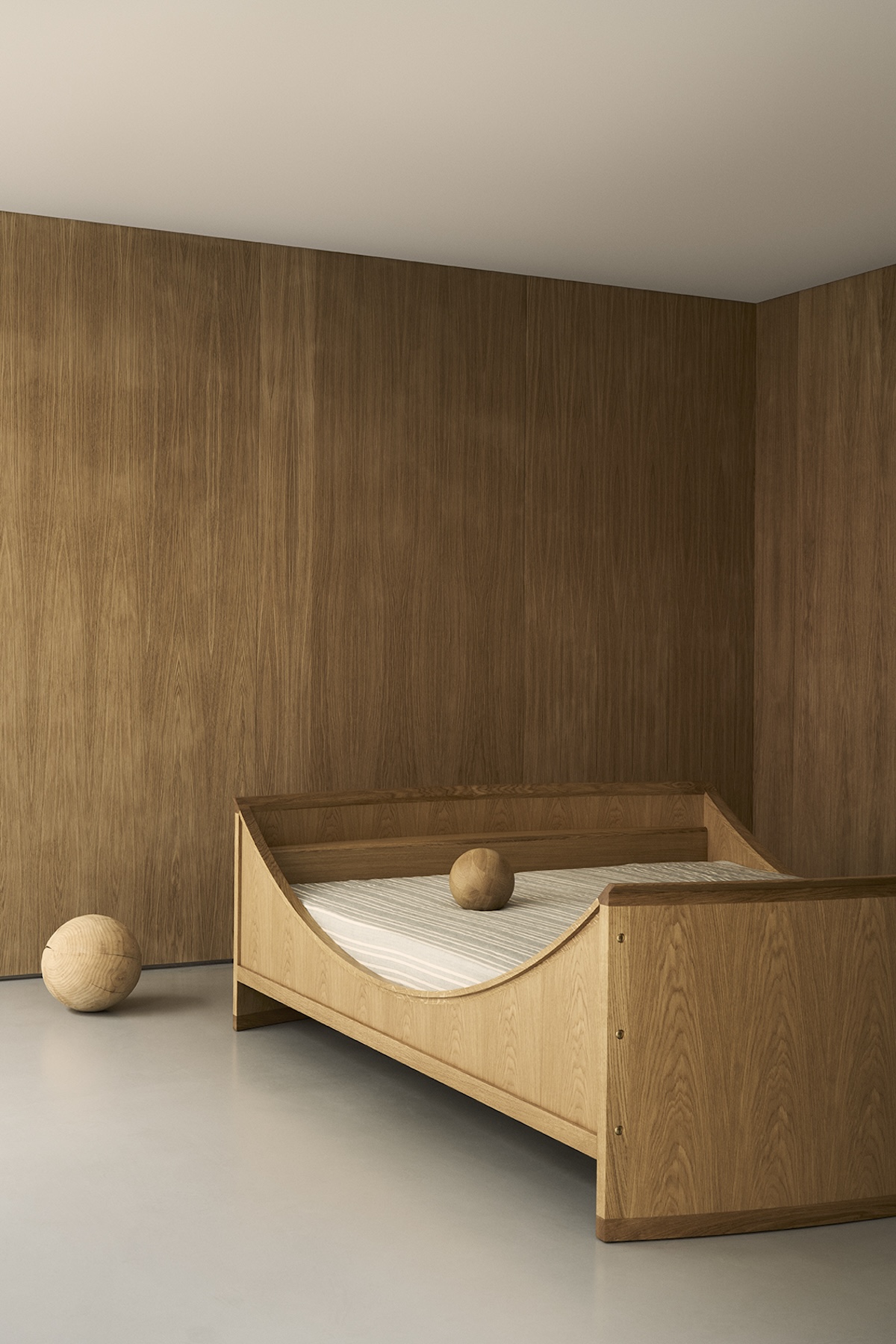
COLLAGE, FRAMA and Faye Toogood
Shaping the Future, Carl Hansen & Søn
Emerson Bailey, the design and antiques gallery based out of Bozeman, Montana and Kullabygden, Sweden debuted Centuries, an exhibition of Scandinavian design from the 18th Century to present day. Alongside the antiques, the exhibition also highlighted contemporary pieces, such as lighting from Sekt, the first reproduction of the Folke Bensow table by Näfveqvarn, the Christianborg tap series by Toni Copenhagen and rugs by Cappelen Dimyr.
In collaboration with French-born and Mexico-based designer Fabien Cappello, known for his vibrant pattern combinations, Swedish design brand Hem launched the Toto lamps — joyful and covetable pieces bursting with color and light.


Centuries, Emerson Bailey
Toto Lamps, Hem and Fabien Cappello
St. Leo, the eco-friendly paint and plaster company, hosted a gourmand installation by NYC-based designer and art director Rafael Prieto in collaboration with local chocolate makers Svend Michelsen. Interpreting a passage from British astrophysicist Arthur Eddington’s book from 1928 The Nature of the Physical World, Prieto’s The Real and Concrete illustrated how substances – in this case chocolate – are viewed in our everyday experiences as the primary constituents of reality, characterized by tangible properties like form, color, resilience.
Local star Bonnie Hvillum’s Natural Material Studio debuted White Utopia, a milky-white installation embodying the studio’s core philosophy of adapting to a world in constant movement. For their most ambitious project to date, Natural Material Studio responded to the theme "Dare to Dream," taking over a full house on the island of Refshaleøen, and adapting their Procel bioplastic to form massive functioning furniture pieces across three separate rooms—a dining room, a lounge, and a bedroom with a walk-in wardrobe.

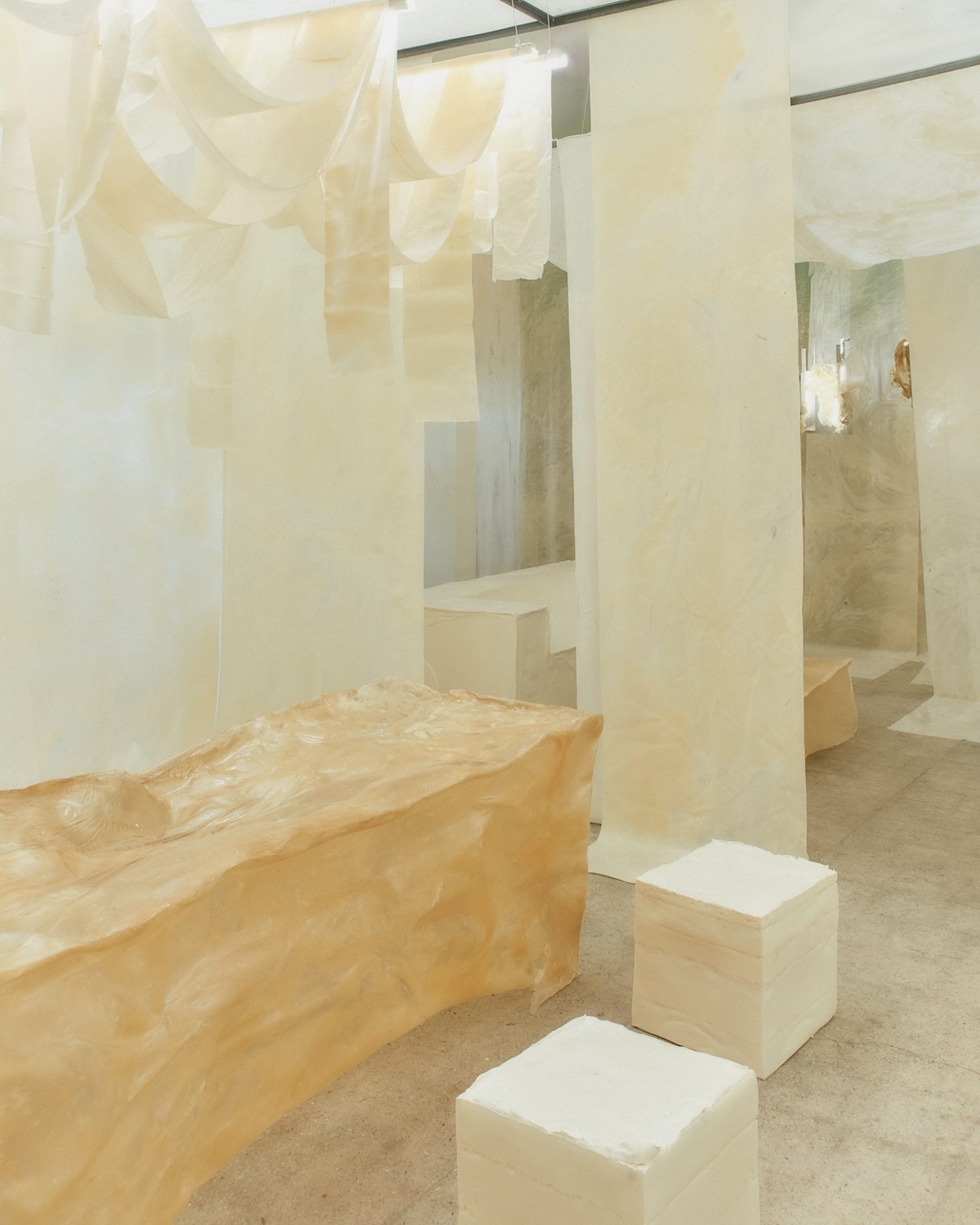
The Real and Concrete, Rafael Prieto and St. Leo
White Utopia, Bonnie Hvillum and Natural Material Studio

The warehouse, home to Sheerly Touch-Ya and Shisanwu LLC, are both headed by artist and Lunch Hour member Serena Chang—the former being her family’s first American enterprise upon migrating from Taiwan, the latter being her sculpture fabrication studio. On May 18th, within the context of these entities — charged by layered histories of artistic labor, material culture, fashion commerce, migration, and manufacturing technology — Means of Production opened the Sheerly Touch-Ya warehouse to the public for the first time in its history. The night of performances from a slew of artists, activists, and creatives was just the beginning of an ambitious eight-week exhibition run, which included an art workers’ town hall on June 8th, and an upcoming film program Out of Circulation organized by third Lunch Hour member Lily Jue Sheng on June 29th.
Behind an industrial metal door with vinyl lettering “SHIS NWU” (the “A” has fallen off), I slip into the Sheerly Touch-Ya warehouse on opening day, the entryway opening into a tiered industrial space full of palettes, plywood, pipes, and metal scaffolding. A thrilling slippage between what is an art object and what is warehouse environs sets in: is an open bag of sweeping compound a work of art? Maybe. The open book on a worktable, or the spectacles on a styrofoam block, with twigs for arms? Probably. Artworks tucked between boxes of hosiery, left unannounced on the concrete floor, or strung up on the rungs of industrial pallet shelves offer an invigorating disorientation.
Works in the show are not clearly demarcated from warehouse supplies — echoing the thesis of the project, which brings focus to the hazy lines between precarious and acknowledged, waged and unwaged labor. To this point, Linh explains, “Our subversive decision to present artworks in a warehouse, rather than a white cube or museum, challenges conventional notions of art and authority. It raises questions about what constitutes art and who has the power to define or value it. This setting infused our project with humor, playfulness, and a sense of freedom — elements that artists and art workers rarely experience today.”
Around 5pm, a group of performance artists begin to wander the entry room with intention, winding small handheld radios while an audience gathers. Performer and choreographer Anh Vo’s Common Fetish calls on a wide list of citations including “Vietnamese possession rituals, Communist propaganda, Nicki Minaj, Jacques Derrida, Christina Sharpe, Thich Nhat Hanh,” among others. At times evocative of a Buddhist chant, a Catholic prayer, a rodeo speech, or a pledge of allegiance, the performers Anh Vo, Kristel Baldoz, Kris Lee, and Nile Harris engage in a call and response. “I am a hole for you to penetrate,” they speak in unison while transitioning from floating independently to a ritual circle. As the procession of performers and audience members trickle deeper into the warehouse, down a dark aisle of boxed stockings, Ethan Philbrick plays the cello in deep bellows and sharp picks. Some clothes are removed and the script becomes darker. Movements become less rhythmic, more rattling, more haunted. The push and pull of performers and bodies, in both possession and dispossession, signals to the interpenetrating nature of the sexual, the spiritual, the psychic, the political, and the somatic all at once.







Artist and writer Amy Ching-Yan Lam then begins a live reading of seven large printed posters lining a hallway near the warehouse entrance, with words based on conversations she has had over the past seven months with herself and others. Equipped with a laser pointer and microphone, Lam reads off “Top 20 reasons why I’m not withdrawing my work or participating in a boycott against Israel or other corporations, organizations, or states that are complicit in the ongoing genocide of Palestinians” in a biting, flat delivery, one of the stated “reasons” being “WHY ARE YOU ATTACKING ME?” Shooting through bullet points, Lam ends on the posters, “Top reasons why I let these beliefs poison my solidarity with Palestinians,” the only reason listed: “I don’t know.” “Top reasons why I don’t know” — “There’s no good reason.” It feels like an apt answer to many contemporary questions we are mulling over.
Deeper within the warehouse, Erik Nilson activates his work Oothecean Stanchion by climbing on top of the pallet shelving unit housing his textured, all-white tableaux of wood, plaster, stuffed stockings, and HDPE shavings. Descending into the work, Nilson begins pulling a chain rig, hoisting a large section of a tree upwards, breaking apart from the chalky installation. Nilson tinkers with piezoelectric microphones, amplifying the clinking and clanking of chains into a feedback of electronic drone, punctuated by the wailing of a small amp on the other side of the unit. He mans a drill augmented with a white branch, twirling and kicking up shavings, finally mixing concrete and water into the mold of a white tree stump. As a sculptor and fabricator, Nilson’s performance echoes his professional work, laying bare the residues of material transformation.
In the back of the warehouse, artist vinacringe enters nude, standing behind stockings stretched across the metal scaffolding of a pallet shelf. A high pitch soundscape falls to a low pulsing hum, transitioning to a breathy narration as vinacringe ties stockings taut across their body. “You have gifted me a wound in the shape of the world,” the audio whispers. In a frantic catharsis, they cut through the stockings on them and the scaffold with a large knife, and on their knees, they send out a yell to release themselves from the performance.
Finally the crowd makes its way to Tianyi Sun’s work Dream Skin (Sheerly) consisting of reclaimed windows from the warehouse, referencing Chinese folding screens (or pingfeng), collaged with Sheerly packaging and hosiery. In a site-specific reading, Sun reflects on stages of production, the working body, and the hidden nature of creative labor, peppered with Mandarin.


Tianyi Sun, Dream Skin (Sheerly), 2024, photography by Tallulah Schwartz
With the conclusion of the performances, we free-wander the dark alleys of pantyhose boxes, soaking in the sense of discovery. The works, too many to name, each address the show’s themes in subtle or oblique ways. Tra My Nguyen’s diaphanous textile-silicone figures, collaged with Sheerly tights, converging realms. silicone dreams, reference histories of Asian garment manufacturing, and especially forms of labor exploitation therein. Especially considering Balenciaga’s recent plagiarism of their master’s thesis, Nguyen’s suspended sculptures summon issues of authorship and the appropriation of creative labor, especially that of BIPOC artists and designers, as well as the opacity of foreign manufacturing to American consumers writ large.
Serena articulates this intersection well: “Means of Production for me, was to engage the conversation around labor. How labor is often deflected onto others (intentionally or not) within our capitalist society. In the setting of the hosiery warehouse and sculpture fabrication, the opposing worlds of mass production and unique sculpture fabrication is the ideal setting to address this conversation. In this age of globalization where labor is hidden and objects can be ordered and delivered the next day, our collective understanding of labor has become so obscured.”
Most crucially, Means of Production offers a refreshing model for exhibition organizing and curatorial method. Really, you could call it a non-framework — built around site-specificity and free-form engagement with it, full creative agency, collective organizing, and a generosity of resources. Every artist who applied to the open call, Lunch Hour tells me, was accepted. The show’s loose concept — applicable to all — allowed for multifarious interpretations. The curators’ and Shisanwu’s volunteer effort fundraising from the public as well as their pocket money largely made the project possible. In Lily's own words, "...so much [funding] is tied up with weapons manufacturers, the non-profit industrial complex, predatory real estate, the state, and mega corporations. It made sense to experiment by self-organizing collectively and in a big way, since that’s how labor power is organized, right?"
The biennial-scale Means of Production ironically feels minimally produced, which is perhaps entirely in line with its mission. In the time of W.A.G.E. for cultural work and growing consciousness of the tentacular ways in which racial capitalism constitutes our contemporary world, the project’s unstructured nature seems perhaps the most congruous response to such questions: in a contemporary capitalist work-relation, how does immaterial labor become economized? How does art and the self become commodified? Are these actually the same question, repackaged?

Raised by artist parents who imbued much of his cultural understanding during his upbringing, Salomão traversed childhood with an insatiable thirst for knowledge and an innate curiosity. "What I gained from my parents was very precious. My mom and my dad were kind of these encyclopedias of culture," reflects the New York-based artist.
Growing up amidst Brazil's Tropicália movement, a creative and musical revolution that was born from Bossa Nova and the oppressive regime of the time, Salomão was exposed to a golden era of music that sparked a profound awakening within him. While his parents were spiritual seekers, it was music that served as his initial gateway to the spiritual realm, a connection that still resonates deeply in his life today. "My first connection with the spirit world was actually playing Jimi Hendrix’s music," he explains. "During that journey, I realized there’s something else besides this reality. We can also paint our reality from the inside out. I didn't even know how to really play [guitar], but I was in a trance. I connected with the music, and I was in a trance with this spiritual world."


Drawing inspiration from the music of the 1960s and 1970s, delving into the writings of Carlos Castaneda, and immersing himself in Afro-Brazilian Yoruba, Buddhism, and Tarot, Salomão's spiritual immersion in Brazil was just the beginning, laying the groundwork for how he would navigate life and express himself creatively.
Arriving in New York in the 90s, 15-year-old Salomão found himself in the underground punk scene of the Lower East Side, skateboarding and playing in bands while absorbing all the cultures that inhabited the neighborhood. “I feel like New York was such a poetic place back then, where it was raw, the Lower East Side, the village was so raw” Salomão recounts.
Navigating the concrete jungle, the multidisciplinary artist discovered graffiti as a means of self-expression beyond his musical pursuits. "I had this urge to express myself, and it came through graffiti. I started to paint this name, this rebel name called ‘PIXOTE.’ It became a mantra. It was very much about me finding myself and my individuality," Salomão explains. "Putting up your name, you become a part of this landscape, this urban landscape. This opened the door to the visual arts, where I feel like all art forms are interconnected."


Since venturing into visual art, Salomão has continuously pushed the boundaries of his craft, refusing to conform to the constraints of medium or categorization. "I'm more of a visual poet or a multimedia artist. I don't particularly say I'm a painter. Even when I paint, I feel like an alchemist because I'm dealing with energy. And, that's how I see paintings or art being a tool of healing. A tool of actually bringing people outside of this normal reality, and to embrace this mythical world."
For Salomão’s latest offering for his solo show “CIRCO DE VISÕES," paintings, works on paper, and sculptures act as vessels for abstractions of daily life. Creating an assemblage of found objects from scrap metal to Salomão’s father's journal entries, creative brevity ties the work together. “There is a notion of freedom in each artwork that I do, almost like a tarot card. I embrace this freedom. I don't have a form of how I'm gonna make actions, but I have this little connection with the work, which it's kind of a spiritual dialogue with each work” the intentional artist expresses while the sun illuminates his silhouette. “I let the paint lead the way. I prime the canvas, and then a lot of times, I leave some coffee stain, oil stain, or linseed oil, letting the stain lead the way of how I want to build this art form.”
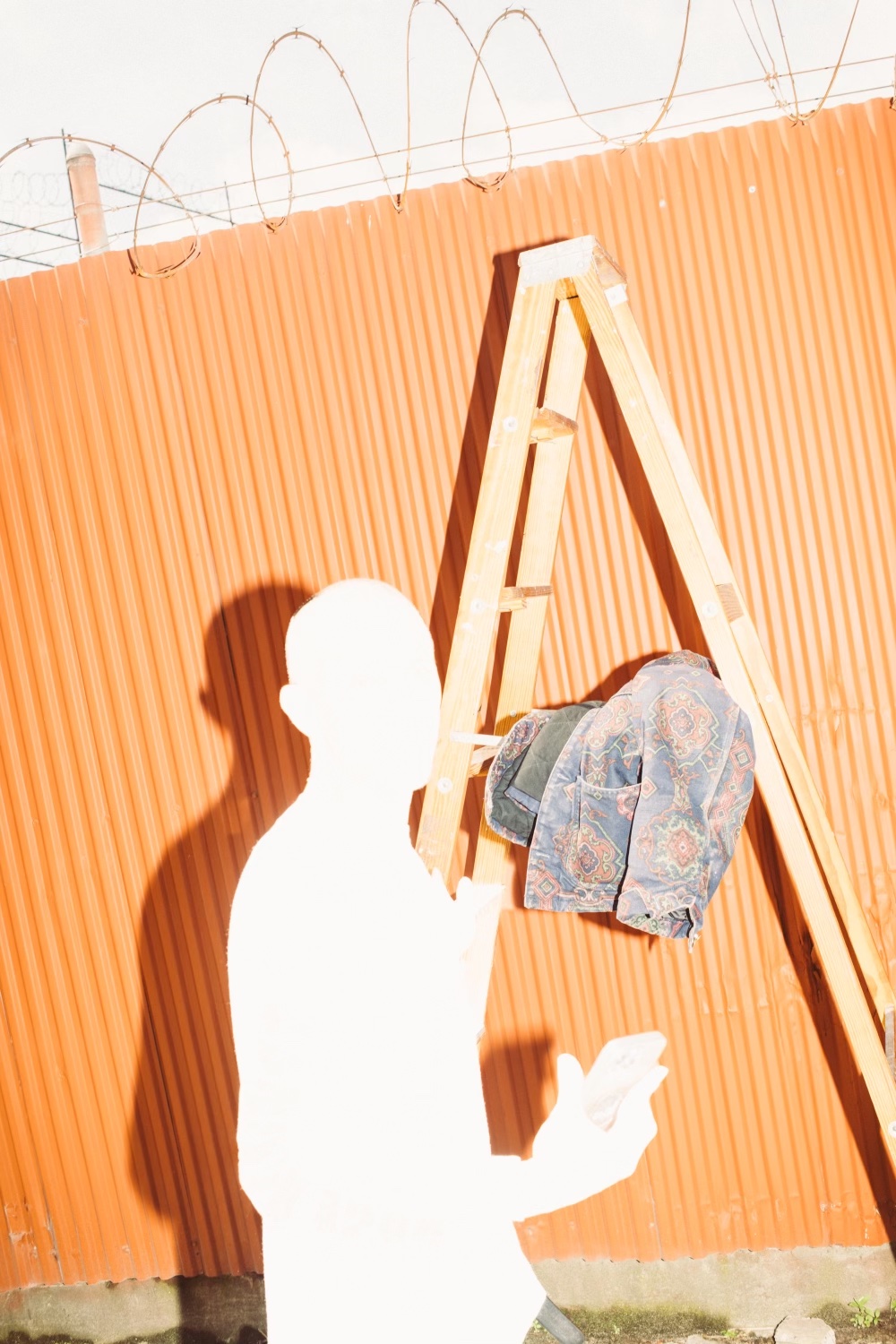

The compositions of Salomão’s paintings are an amalgamation of sourced materials, graffiti, and oil paint, accentuated by Japanese caligraphy-inspired brushstrokes and a palpable sense of urgency. “A lot of my work has these collages of patches, fabric that I've been collecting, or that I maybe already painted. And I think they have a life of their own own and own knowledge” he observes. “I also brought in elements of a construction site, little things that I saw on the street that I love in terms of the mask that they used in construction, and I like this urban fascination for imperfection.”
While painting allows Salomão to articulate the thickness of his mind, works on paper oftentimes are an easier form of expression. “My art is completed by the viewer. I give a lot of gaps for the imagination, for one's perspective” he expresses. Inspired by his father’s poetry and ephemera that was recently passed down to Salomão, “CIRCO DE VISÕES," came to be through “this unconscious world of symbols, archetypes, and title cards” in his words. “My father being a poet, and leaving me so many artifacts, little journeys, and poems, I was looking for a name–and it came to me.”


Anchoring the show is a new arrival for Salomão, where he is presenting a sculptural homage to Marcel Duchamp’s 1913 Bicycle Wheel. Tied to the spirituality of Dadaism and Duchamp’s artistic objectives, Salomão's art merges his external and internal worlds, unified by the spirituality that connects them.
As you step back and observe the dialogue within each of Salomão’s artworks, a collective exhale takes place. In a world constantly in pain, with futures appearing increasingly bleak, Salomão’s art serves as a reminder that accessing a higher consciousness through art, music, and meditation can foster a stronger, more connected sense of being with the world around us. He states, "I realized very early on that spirituality is something for us to connect to within our lives. Often, we are so consumed with our outer world and everything happening there that we forget our inner world and the importance of tapping into that."
“CIRCO DE VISÕES” is on view at Gallery 495, Catskills, New York, running through July 27.




